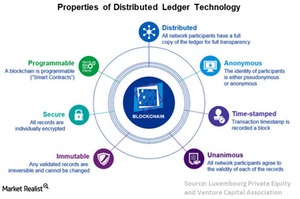What Imparts Transparency to Digital Assets?
Digital assets based on DLT (distributed ledger technology) allows users to initiate and verify their own transactions without any central authority such as banks.
Jan. 29 2018, Updated 1:18 p.m. ET

VanEck
Skeptics view digital assets as opaque. What can they be used for and who will accept them?
Actually, digital assets are radically transparent, with publicly available codes and transactions. Codes can be copied by virtually anyone with the technology and desire to do so. Digital asset users are trackable by public keys (although personal identities are confidential).
Digital currency or coins have countless applications. The use of coins and how they are accepted are typically described on the applicable website, and on sites like Medium, Reddit, and Telegraph. The technology is also arduously explained on YouTube.
Market Realist
Users can initiate and verify their own transactions
Digital assets based on DLT (distributed ledger technology) allow users to initiate and verify their own transactions without any central authority such as banks (XLF) (VFH). The technology (SOXX) (SOXL) provides control of all the information and transactions to the user, who can also maintain their own copy of the ledger. All the transactions are simultaneously updated in all users’ copies. Since users can initiate and verify their own transactions, the system is less prone to error. The use of a single and publicly available ledger reduces complications associated with recording the transactions at various locations. As a result, the system greatly reduces the risk of unauthorized modifications and the possibility of data tampering.
Users cannot remain anonymous
All the transactions on blockchain technology (ARKW) are easily traceable, thus imparting greater transparency to the system. To initiate a transaction on the platform, users need to create addresses based on their wallets, and while doing so, they have to reveal their identity. Thus, users cannot remain anonymous on the system. These addresses then become the backbone of all the user’s future activities. Anyone can see the balance and transactions of any address.
